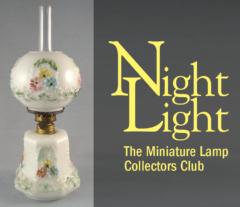 Fortunately, not many Victorian miniature lamps have been reproduced. One of the more confusing reproductions is the Stars and Bars (SI-482). This lamp was reproduced in the 1950s thorough the 1960s by the L.G. Wright company and called Daisy and Cube. While it is often difficult to tell the old from the new, the following tips should help:
Fortunately, not many Victorian miniature lamps have been reproduced. One of the more confusing reproductions is the Stars and Bars (SI-482). This lamp was reproduced in the 1950s thorough the 1960s by the L.G. Wright company and called Daisy and Cube. While it is often difficult to tell the old from the new, the following tips should help:
Color can be a important clue. The original Stars and Bars was made in clear, amber, green and blue. The reproductions were made in amber, blue, green, amberina and milk glass. So if you have a clear one, it is old and original and if you have a milk glass or amberina lamp, it is an L.G. Wright reproduction. So the problem colors are amber, green and blue. There are some differences in the color shadings of the old and the new, but those can be difficult to discern. So let's go on to dimensional differences.
 The most obvious difference is the height of the shade and the shape of the design on the shade. Shown above are pictures of the original Stars and Bars lamp on the right and the L.G. Wright Daisy and Cube on the left. Note the difference in the shade. The reproduction shades are typically about 2 5/8" tall while the original shade is 1/4" shorter at 2 3/8". You say you don't carry a ruler with you? No problem. Look at this photo with a close up of the "star" face on the shade. Again the original is on the right. Notice that the original has a round shaped facet, while the reproduction has an oval shaped facet.
The most obvious difference is the height of the shade and the shape of the design on the shade. Shown above are pictures of the original Stars and Bars lamp on the right and the L.G. Wright Daisy and Cube on the left. Note the difference in the shade. The reproduction shades are typically about 2 5/8" tall while the original shade is 1/4" shorter at 2 3/8". You say you don't carry a ruler with you? No problem. Look at this photo with a close up of the "star" face on the shade. Again the original is on the right. Notice that the original has a round shaped facet, while the reproduction has an oval shaped facet.
Bases are more difficult to determine old from new. Some have suggested that the shape of the font above the band is a key, however I have seen both old and new lamps with rounded fonts and with relatively flat fonts. It is my opinion that those differences are more of a function of how quickly the part was removed from the mold. But there are some things to look for. On all of the originals I have seen, the stem of the lamp is divided into six well-defined panels while the stem on the newer lamp seems much rounder with only faint hints of the sections. Again, this may be a function of mold age. Another clue is to take off the burner and examine the size of the hole for the wick and the color of the material used to bond to collar to the lamp. The newer lamps tend to have smaller wick holes and have whiter bonding. This is also difficult to discern unless you have two lamps side-by-side. So treat these as clues rather than hard and fast rules.
